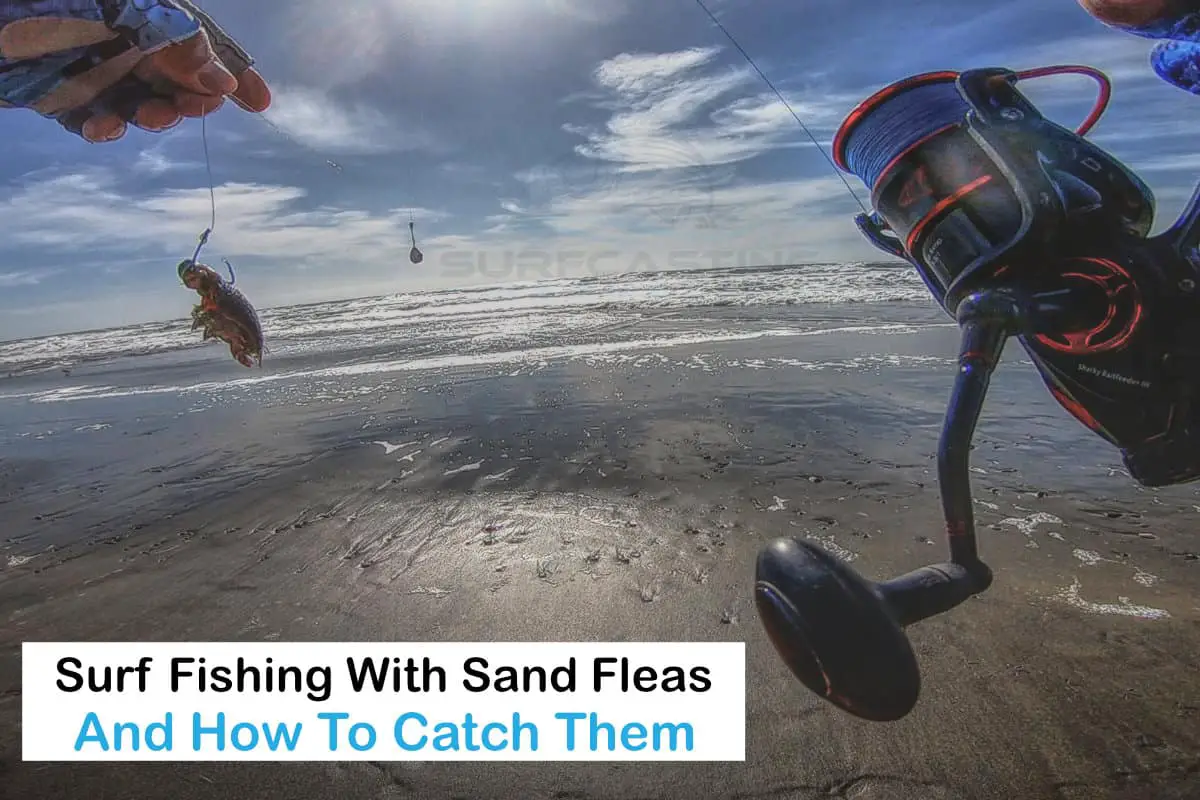Sand fleas, also known as “mole crabs or sand crabs,” are small crustaceans that you’ll find running around many coastal beaches. Since sand fleas are so prevalent in many surf fishing areas, people often wonder how to surf fish using these plentiful creatures as bait.
If you’re curious about how to accomplish this type of surf fishing, know you aren’t alone. So, how do you surf fish with sand fleas?
To help you understand how to surf fish with sand fleas, you’ll need to learn the process of collecting, keeping, and hooking sand fleas. You will also want to know how to set up your rod and reel, find the best fishing spot, and cast your line effectively.
Since there isn’t a lot of information on the Internet today that covers how to surf fish with sand fleas, I decided to help you out and combine all that knowledge into one easy to follow guide.
I will cover all the topics listed above so that you can begin surf fishing with sand fleas successfully.
What Are Sand Fleas?
These small crustaceans also called “mole crabs, or sand crabs![]() ” are a decapod crustacean. Ten different species of sand fleas can be found on beaches all over the world.
” are a decapod crustacean. Ten different species of sand fleas can be found on beaches all over the world.
In the United States, two of the most well-known types of sand fleas originate from the Gulf Coast and are called Emerita Talpoida or Emerita benedicti.
If you’re fishing in North America, especially around the Gulf Coast area, you’ll be using one of those two types of sand crabs.
So, do the fish have a preference for one of these sand crab species over the other? Not really.
Most of the fish you’ll be aiming for when you surf fish will enjoy eating sand fleas of any variety, so you don’t need to put too much thought into the type of sand flea you are using.
Honestly, you’ll be better off fishing with the sand fleas you’ll find on and around the beach from which you are fishing.
Local sand fleas will be natural prey for fish in the area.
Since sand fleas are so prevalent in many coastal regions, it won’t be difficult to catch sand fleas right off the same beach where you are fishing, and you can then use those sand fleas as bait.
Most of the fish you’ll be trying to catch while your surf fishing will love sand fleas.
If you use the species of sand fleas, the fish are already used to eating; you’ll increase your chances of attracting a strike.
So, as we get deeper into this article, we will cover how you can catch and keep your sand fleas.
Sand Flea Characteristics
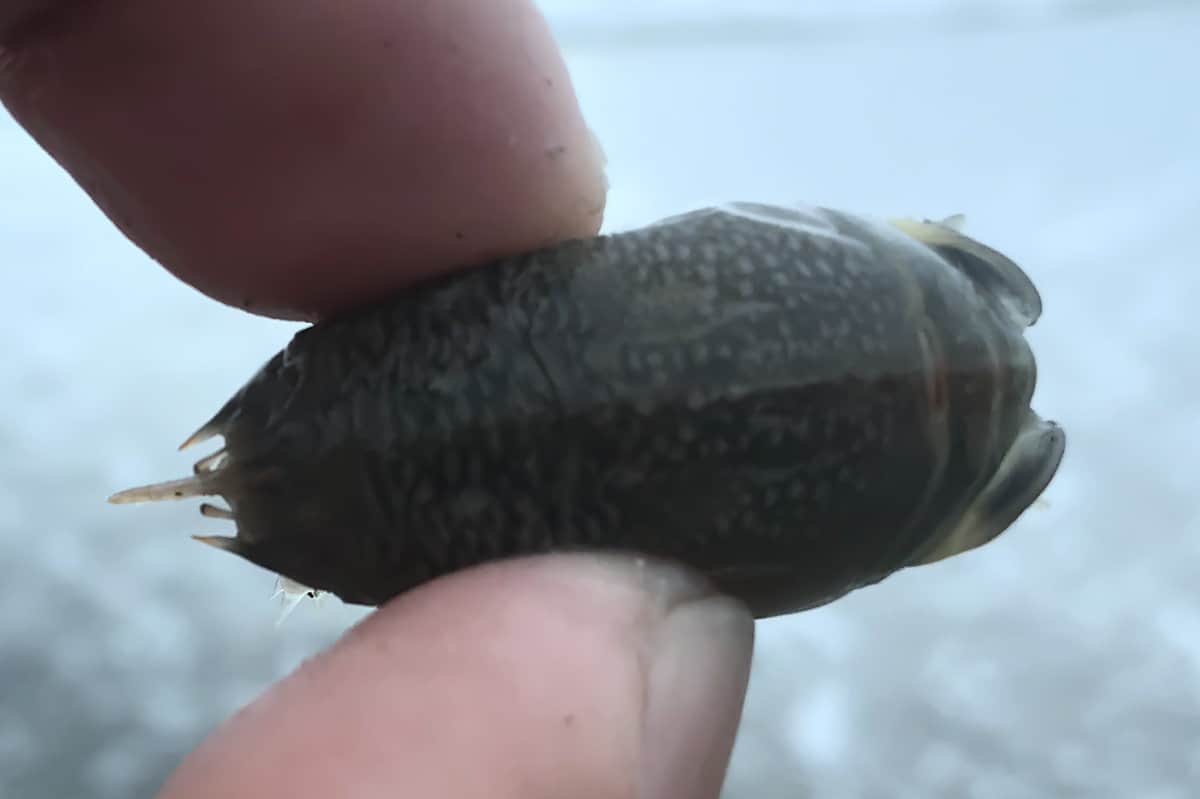
Your average sand fleas generally remain small in size. Most sand fleas are between a half-inch to an inch long.
Females can be much larger than males, and some females grow to be as big as two inches in length.
Most male sand fleas will only grow to about ¾ inches long.
Another distinctive mole crab characteristic is their five sets of legs that can be found on the underbelly area.
These legs help the sand fleas move through the water, and they also assist them when they need to dig in the sand.
Something else that’s unique about the mole crab is that they always move backward.
Mole crabs can easily travel across wet sand and get back into the water. However, if you put them in dry sand, they won’t be able to move very far.
Why is it that and fleas won’t get very far once they are placed in dry sand?
As a clawless species of crab, they breathe using gills. Oxygenated water must be pushed through the gills so that the sand flea can survive.
So, the wet sand the sand fleas prefer prevents their gills from drying out.
While sand fleas can survive out of the water for anywhere from a few hours to a few days, they will die if their gills dry out.
In arid sand, their gills will dry out faster, and they also won’t have access to the oxygenated water they need to survive.
Now that we’ve covered some essential sand flea characteristics let’s move onto discussing how to catch sand fleas for surf fishing.
Then, we’ll discuss how to keep sand fleas, how to place them on a hook for surf fishing, how to set-up your rod and reel, how to find the best spot![]() to surf fish, and how to cast with sand fleas for surf fishing.
to surf fish, and how to cast with sand fleas for surf fishing.
How to Catch Sand Fleas for Surf Fishing
As it is a good idea to gather your sand fleas from the same beach you plan to fish off of, you’ll need to know how to catch these critters.
Capturing sand fleas can provide a fun adventure for the entire family, and children often love doing this.
Plus, you’ll be able to collect a lot of free bait that will bring you success in all of your surf fishing endeavors.
Below, we’ll cover the steps to teach you how to catch sand fleas for surf fishing.
Step #1: Visit the Beach when the Tide is Low.
Why would you need to visit the beach![]() when the tide is low to catch sand fleas successfully? Sand fleas are most exposed at low tide.
when the tide is low to catch sand fleas successfully? Sand fleas are most exposed at low tide.
Once the tide gets low, the little areas that the sand fleas are burrowing and living in become easily visible.
You’ll be able to spot those small areas and then snatch up a handful of sand fleas quickly.
Step #2: Find A Hole on the Sand
When sand fleas dig themselves into the sand, they leave a hole that easily allows you to find them. If you’re good at spotting these
If you find a soft portion of the sand on the beach, chances are you’ll catch a few sand fleas that are burying themselves beneath the sand.
Step #3: How To Catch Sand Fleas?
The last step is to snatch up all the sand fleas you can find. You can do this using your hands, a shovel, or a rake.
Another neat trick that I’ve learned is to use a sand crabs net or rake to catch them.
Using this method, you want to place sand crabs net in the area where you found the sand fleas and then kick the sand around that area to loosen it.
Finally, watch the tide roll in carrying the sand fleas into your net, trapping them for your use.
Now that you know how to go about catching sand fleas, you’ll need to know how to store your sand fleas in a manner that keeps them viable as bait for surf fishing![]() .
.
How to Keep Sand Fleas for Surf Fishing
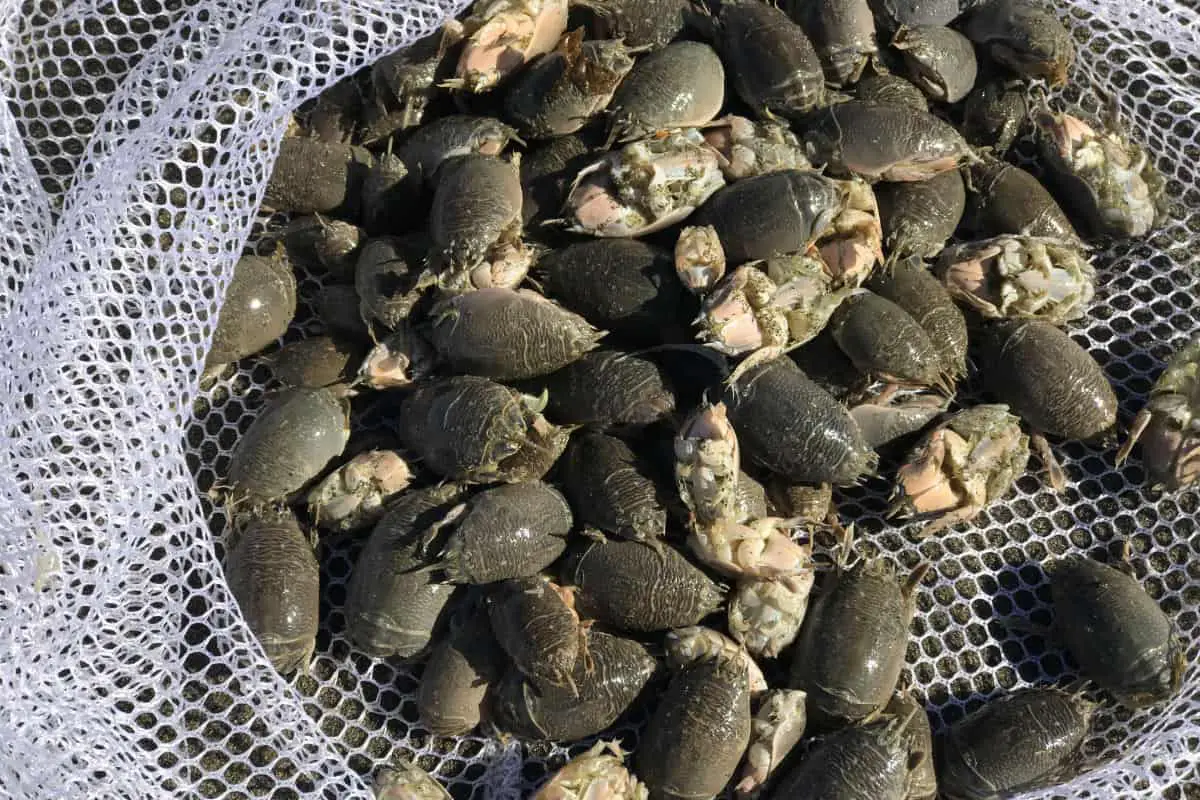
Now that you’ve caught a bunch of sand fleas, you need to know how to keep them safe.
If you plan on using sand fleas as bait, you’ll still need to keep them alive for the rest of the excursion. I only catch sand fleas that I think is enough for me to use.
I catch them and use them right away, I always prefer using them while they’re fresh and alive.
I use a waist bait bucket to store them, so when I ever needed to change my bait I can always grab anytime.
However, sometimes you need to catch sand fleas for your next fishing trip, and you want to have a bait ready as soon as you get to the beach.
What do you do to make sure they don’t escape and keep them safe for your next big catch? Keep reading to find out:
Step #1: Put Your Sand Fleas in Moist Sand
When I gave you a brief overview of sand fleas above, I mentioned why it’s important to keep sand fleas in moist sand for survival.
To keep your sand fleas, I recommend getting a bucket and then placing all of the sand fleas in your bucket that has a few big heaps of moist sand inside of it.
Remember, sand fleas need moisture so that their gills remain wet, and that’s the reason for using moist sand.
If you place your sand fleas in dry sand, they will stop moving, their gills will dry out, and they will eventually die.
Since you want your bait to be as fresh as possible, you don’t want to kill off your sand fleas hours before you’re able to catch anything.
However, if the weather is scorching, you’ll need to take a few extra precautions to ensure that the gills of your sand fleas won’t dry out.
You’ll want to place a damp cloth over the moist sand if it’s a sweltering day.
You could additionally cover the fabric with ice chips so that the sand fleas stay moist and cool.
Step #2: Keep the Bucket Clean
Depending on how much fishing you plan to do on a particular beach, you can keep sand fleas alive for around three to four days in a bucket of moist sand.
However, if you do intend to keep your sand fleas in the same bucket for that long, then you’ll need to empty it daily to remove the waste they generate.
Your sand fleas will excrete a yellow-colored waste that has to be taken out of the environment, or else the sand fleas will suffocate.
Step #3: Freeze the Fleas
If you tend to hit the same beach and fish there often, then you can also preserve your sand fleas and use them later.
Preserving a few extra sand fleas is also helpful for those days when you have difficulty finding them.
Depending on the tide, finding sand fleas can be quick and easy, or it can be a long, arduous process.
Having a few preserved sand fleas on hand can be useful for those difficult days, allowing you to get fishing without the hassle of having to spend hours foraging for bait.
Some people freeze sand fleas by blanching them (lightly boiling) and then freezing them.
However, the freezing can damage their hard shell, which leads to losing them off the line when you cast or when they splash into the water.
Note: I found this topic on the forum. I have not done this personally. But I think it’s a piece of very useful information if you want to try doing this.
FishinMortician from surfishingflorida.com uses a supersaturated salt solution to preserve fleas that better retains the rigidity of their shell. In order to create this solution, you need to bring enough seawater home with you to cover the sand fleas and a bit more.
Follow these steps to preserve your sand fleas:
- Heat the ocean water on the stove until it comes to a boil.
- Next, add in pure salt—no additives—until the water can retain no more salt, you will see it begin to collect on the bottom of your pot. (The heat allows the water to absorb more salt than normal creating a supersaturation).
- Pour the water into a resealable container of plastic or glass (no metal).
- Place the container in the freezer to cool it down to almost freezing.
- As the water cools, wash your sand fleas to remove debris and impurities.
- Take the nearly freezing water out of the freezer and place the sand fleas in the saltwater slurry (this kills them more humanely than boiling and preserves the integrity of their shell).
- Leave them in the solution and place it in the fridge for 3 to 4 days.
- Portion into single trip sized bags or containers, so you don’t have to take the whole lot when you go fishing.
The supersaturated solution preserves the sand fleas while maintaining the structure of their shell, which allows them to stay on your line better.
You can also place these fleas into a freezer—as long as the temperature isn’t set too low—without freezing them because the salt lowers the freezing point of water.
Using seawater ensures that the sand fleas retain the same smell that attracts the fish.
Now that you know how to gather up sand fleas and keep sand fleas as bait, we’ll discuss how to hook a sand flea for surf fishing.
How to Hook a Sand Flea for Surf Fishing
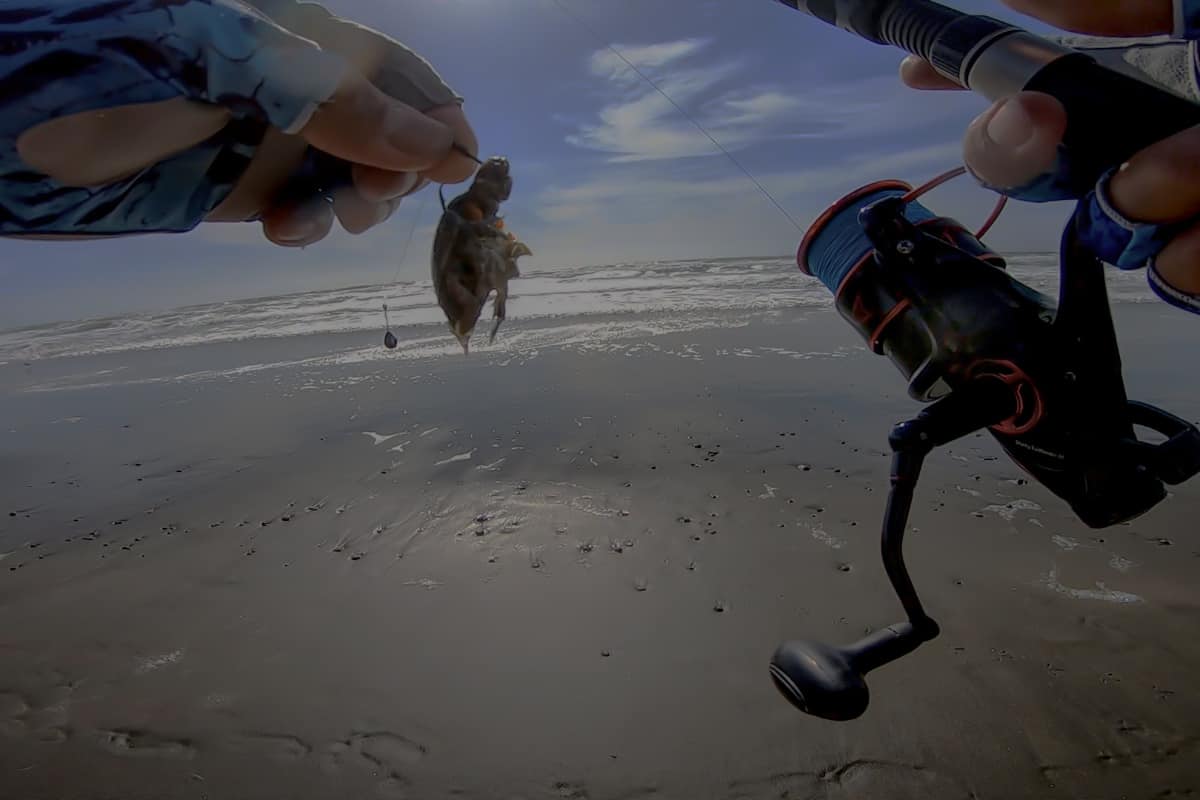
Once you’ve got collected and properly stored your sand fleas, you’ll need to know how to put them on your hook correctly for surf fishing.
Check out this step-by-step on hooking your sand fleas for successful surf fishing:
Step #1: Add Attractor Beads
If you’re using sand fleas as your bait, one of the best things you can do to attract fish is to add a few attractor beads on your line.
You should use one that’s orange in color because sand flea eggs are orange.
Several anglers feel that the orange color of the sand flea’s eggs usually attracts fish that like to snack on these tasty treats.
Thus, adding orange attractor beads will help to get the fish’s attention.
You can also consider using a small, fluorescent orange bobber since it can create the same illusion as the beads.
As a bonus, bobbers can also help you keep your bait off the ocean floor.
Step #2: Add a Small Mono or Fluoro Leader
You’ll also want to add a small mono or fluoro leader into the mix.
If you’re an angler that likes using lighter lines of around 10 to 15-pound test, you should opt for a higher test monofilament leader, look for something in the 25-pound range.
It is also helpful to place a snap swivel on the line because you’ll be able to swap out your hooks and lures more efficiently.
Step #3: Add Line Weight
Next, you’ll need to add a bit of additional weight to your line. Some anglers prefer the small split shot when they want extra casting weight.
Other anglers use sinkers that can weigh up to 4-ounces, but that often depends on the spot in which they are fishing as well as the type of fish they are looking to catch.
I prefer to use 3 ounces either pyramid sinker or disc siker. If you want to learn the different sinker![]() you can use for surf fishing, check this article.
you can use for surf fishing, check this article.
Step #4: Get the Right Hook
You’ll also need to make sure that you are using the right type of hook.
When using sand fleas as your bait, you’ll want to use one of these two types of hooks:
● The Kahle hook, which is a favorite of Pompano anglers. This type of hook has a wide, round bend that pushes the point of the hook back into the middle area near the shaft.
You can also use circular style hooks that resemble the Kahle hook, as these work great with sand fleas.
● The long-shafted hook, size 1, is the type of hook that many Sheepshead anglers like to use.
Step #5: Lightly Hook the Sand Flea’s Body
When you place the sand flea on your hook, you’ll be hooking the sand flea through its body.
Take the point and place it up through the sand flea’s body just above the tail area and move the belly sac towards its head.
You want to ensure that your sand flea can still lay eggs once you retrieve it.
The hook will most likely run through the sand flea’s body at an angle, making the sand flea pull to the side when you reel it in.
Some anglers like placing the barb of the hook through the sand flea’s shell while others like to poke the point through the shell, some fishermen also remove the sand flea’s hard outer shell.
Regardless of how you finally decide to hook your sand flea, you want to hook it lightly.
By lightly hooking your sand flea, you know it won’t get hung up on obstacles as easily.
Surf Fishing with Sand Fleas: How to Set-Up Your Rod and Reel
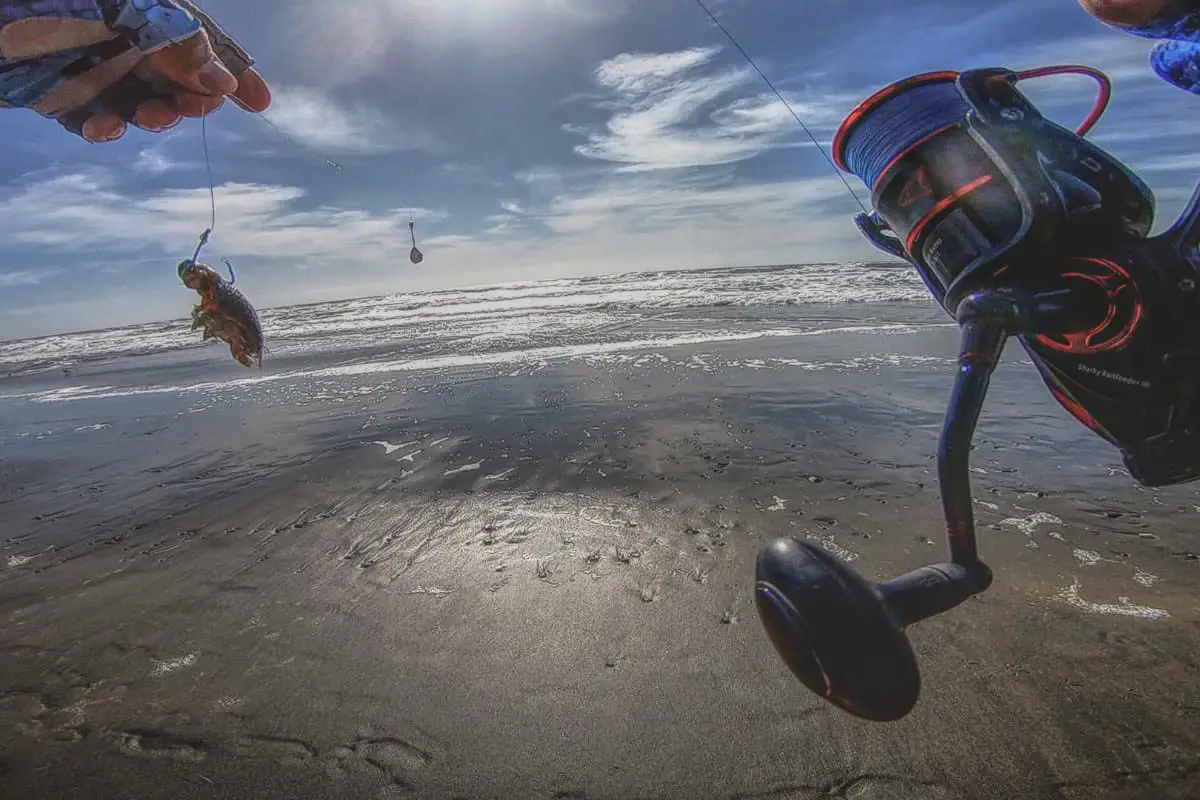
It’s fairly straightforward to learn how to surf fish with sand fleas. Surf fishing![]() allows you to catch fish from the shore, eliminating the need for an expensive boat.
allows you to catch fish from the shore, eliminating the need for an expensive boat.
You don’t need much tackle to get started with surf fishing, and you can surf fish anywhere on the coast.
It is such an enjoyable experience because of the many different types of fish you can catch.
Now that you know how to use sand fleas as bait, we’ll tell you how to set-up your rod![]() so that you can surf fish with sand fleas.
so that you can surf fish with sand fleas.
Step #1: Purchase a Surf Spinning Fishing Rod (7-10 Feet)
If you don’t already have one, you’ll need to make a quick trip to a sporting goods store or a local tackle shop in your area to pick up a quality rod.
You’ll want to purchase a surf spinning fishing rod so that you’ll be able to catch some larger fish without breaking your rod.
Many different fish species![]() might strike your line while fishing in the ocean, and some are quite large, so you’ll need to be well prepared with a heavier rated rod when you surf fish.
might strike your line while fishing in the ocean, and some are quite large, so you’ll need to be well prepared with a heavier rated rod when you surf fish.
If you are planning to focus on larger fish like sharks, striped bass![]() , or red drumming, you’ll need a heavier power rod than the one I recommended above.
, or red drumming, you’ll need a heavier power rod than the one I recommended above.
For those enormous types of fish, you’ll want a heavy rod between 10-12 feet long.
Step #2: Add a Saltwater Spinner Reel
Next, you’ll need to buy a spinning reel that can handle saltwater fishing.
Once you’ve got an appropriate reel, you’ll need to put the foot of the reel into the reel seat around the rod’s handle.
Next, tighten the real seat so that your reel stays where it should be.
Make sure you don’t overtighten the real seat as you might crack the reel.
Step #3: Spool a 20-25 Pounds Line
Now you’ll want to add your spool onto the reel. To do that, you’ll need to tie an overhand knot on the end of your line that wraps around the reel.
Once you’ve got the line attached, spin the handle on the reel.
While you are rotating the handle, make sure you feed the line onto your reel with your free hand.
Remember, how much weight test you have on your line means the amount of pressure that it will take to break the line.
So, if you purchase a more substantial line, then you’ll be able to catch larger fish while you are on the shore.
Step #4: Add a Weighted Pyramid Sinker
Now you’ll be adding a weighted pyramid sinker or any sinker of your choice onto your line’s end.
Try to keep the pyramid sinker weight at around 2 – 3 ounces.
Once you get the pyramid sinker on your line, slide it up roughly six-inches and add a line stopper to secure your pyramid sinker.
Pyramid sinkers work well in moving water.
Step #5: Use a Fish Finder rig
If you’re a beginner, I would recommend to use fish finder rig. It’s the most simpler rig that you can use and still able to catch all the type of species you are after.
Fish finder rig is my go-to rig for surf![]() fishing using live bait. However, you can also use other rig set up like high low rig and Carolina rig.
fishing using live bait. However, you can also use other rig set up like high low rig and Carolina rig.
Check my best 3 rig set up for surf fishing to learn more.![]()
High Low Rig: Another Rig Set – Up That You Can Use.
Now you’ll need to tie two circle hooks onto your line. The hook should be a 7/0 or 8/0 size for those of you that are using large bait to attract bigger fish.
If you’re trying to catch smaller fish, you’ll need to take the hook down to about 2/0 and 4/0.
When you place the hooks on the line, make sure you attach them below the sinker and keep them 3-inches away.
Now that you know how to prepare your rod and reel for surf fishing let’s look at how to catch fish using sand fleas as bait.
Surf Fishing with Sand Fleas: Catching the Fish
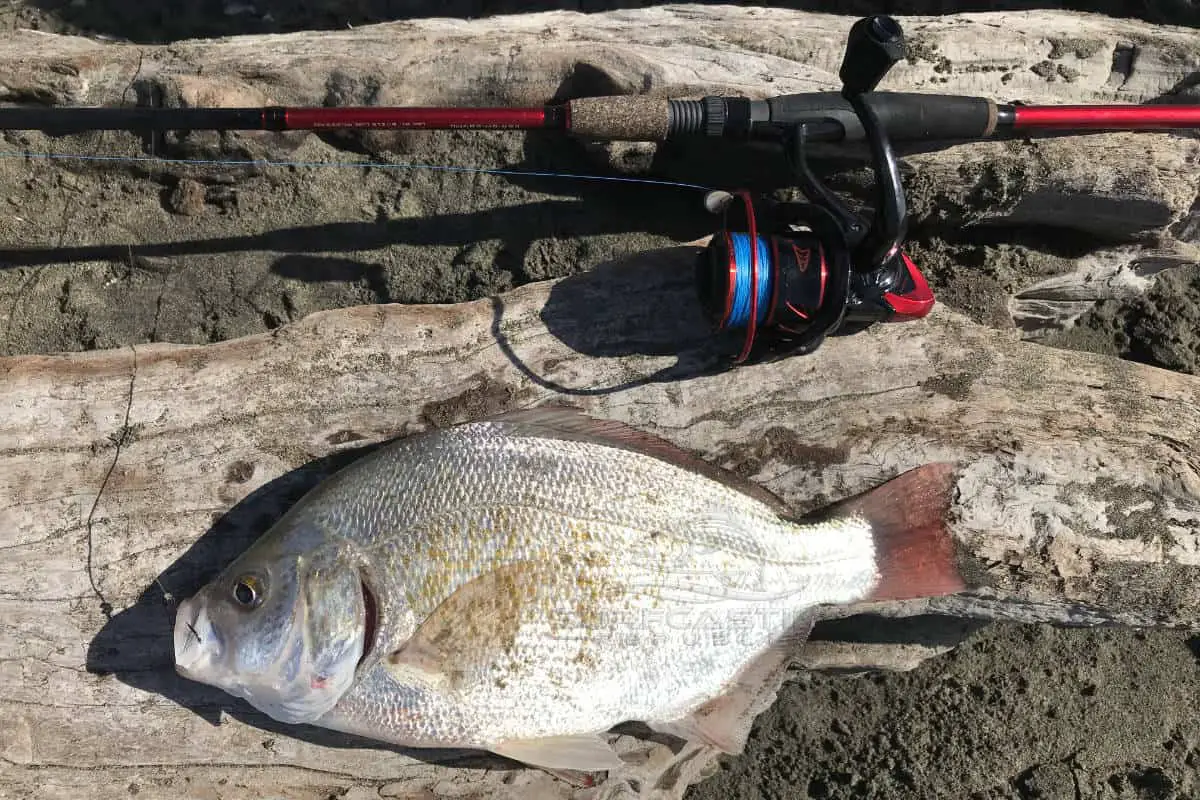
We’ve covered many of the fundamentals as they apply to surf fishing and sand fleas. Now, we’ll cover the most critical part, which is how to catch fish using sand fleas.
Step #1: Use Baits that are Familiar to the Fish
Whenever you are surf fishing with sand fleas, it’s a good idea to use baits that the local fish are familiar with or at least ones that are similar.
That’s why earlier, we recommended that the best way to surf fish with sand fleas is to catch the ones that are already living on the beach in which you are fishing.
That way, your sand fleas will be local, and very recognizable to the fish in that area.
Step #2: Use Chest Waders When Near or In the Water
I recommend using a pair of chest waders![]() when you are surf fishing on or very near to the water. That’s because you are likely to get wet from the waves crashing around you.
when you are surf fishing on or very near to the water. That’s because you are likely to get wet from the waves crashing around you.
When the weather is warm outside, you probably won’t need to wear any special pants or shoes.
However, if you are surf fishing during the colder months, you’ll need the right equipment.
Chest waders![]() will help keep your legs dry when the weather is cold outside.
will help keep your legs dry when the weather is cold outside.
Step #3: Use Polarized Sunglasses
Since you are likely to run into plenty of glare when you fish, you’ll want to consider using polarized sunglasses to help you deal with the UV rays from the sun and the glare off of the water.
With polarized sunglasses, you’ll be able to see better because there will be less glare. You can buy these sunglasses without a prescription.
Since the top of the water often produces a lot of glare and makes it difficult for anglers to see, polarized sunglasses can improve your fishing![]() game.
game.
Amber-colored glasses are best for shallow water.
Step #4: Cast Your Line
Next, open your reel and then cast your line. You’ll want your line to hang about a foot off the rod’s end. Then, open up your reel with the switch so that your line is loose.
Hold the line using your index finger, and then swing the rod over your shoulder to cast it.
Step #5: Close the Reel
Next, you’ll want to close the reel and unspool the line until the sinker hits bottom.
Once your sinker has dropped, remove the slack of your line, make sure your line should feel tight or at least no slack on the line.
Step #6: Watch the Rod
Next, wait for the fish to bite. Probably this will be the best time to grab something to eat while waiting for the fish to find your bait. You’ll want to focus the tip of the rod on seeing if it is moving at all.
If it bends or pulls or you see some resistance, you probably have a bite from a fish, and you’ll want to reel it in.
Step #7: Reel in the Fish
As you reel in the fish, you can allow the waves to help you. You’ll want to make sure your line is tight as you pull the fish to the shore or risk the fish escaping.
You can let the fish take your line out a bit as it fights if you are worried about your line breaking.
Work with the drag of your reel, letting some line out as necessary, and you’ll get your fish close to shore quickly.
To use the drag of your reel effectively, you need to know how to set the drag correctly:
Locate the knob that adjusts the drag of the reel; it is often located on the top of the real when holding the fishing pole in a vertical position.
Some reels have them located on the bottom near the back by the handle; others have them on the side.
Then, you attach the end of the line to a fish scale, have some hold the scale and begin to pull back on the rod-like you are reeling in a fish.
When the line starts to pull off the reel (listen for the clicking sound), then check the reading on the scale.
It should begin to click at 20% of the lines breaking strength, so using a 10-pound test, the drag should be set, so the line pulls off of the reel at 2 pounds.
This will help you avoid a broken line and lost catch should you hook a bigger fish than you were expecting.
Check out the video below by Chris Myers for more information on setting drag and how to use your hand to add extra drag when reeling in your fish.
Credit: Chris Myers
Final Thoughts
Now that we’ve covered how to surf fish with sand fleas, you should be able to enjoy many triumphant surf fishing trips.
Remember, if you catch your sand fleas from the same beach that you are fishing on, you should experience a decent amount of success.
So, now it’s time to get out there and start surf fishing![]() with sand fleas! Go out and catch some fish!
with sand fleas! Go out and catch some fish!

